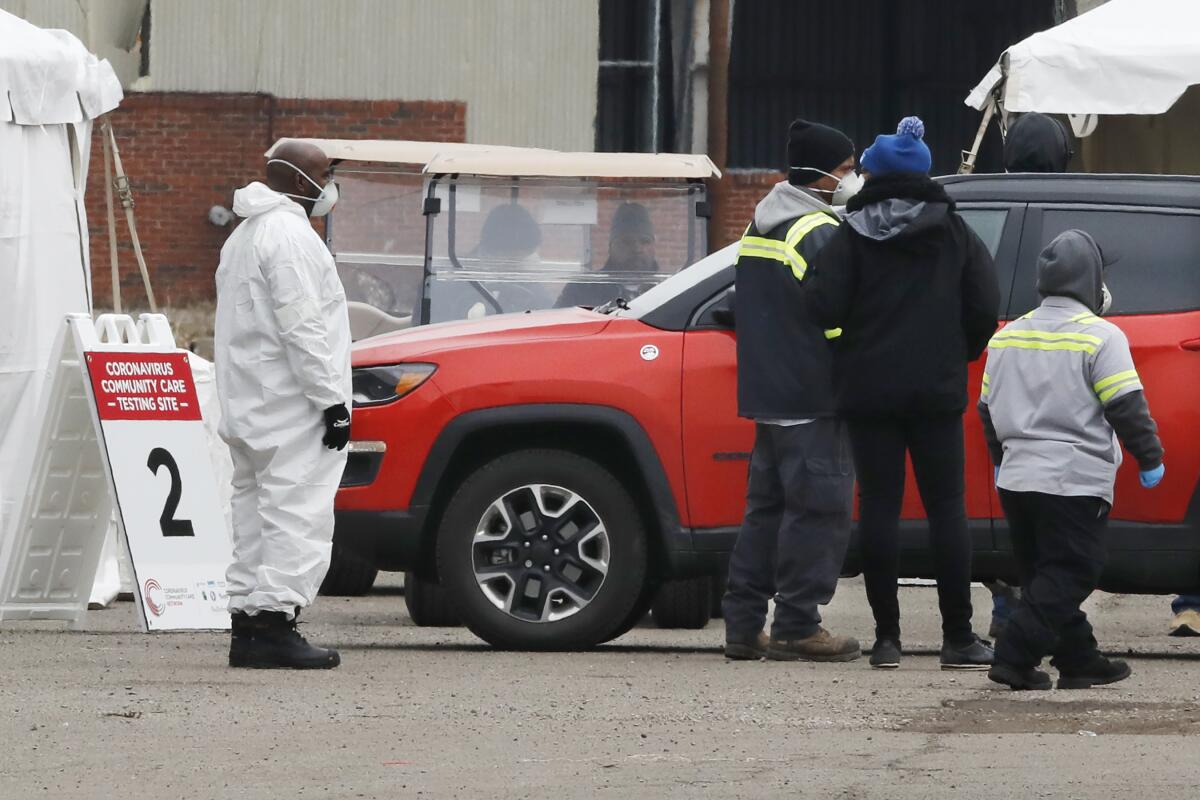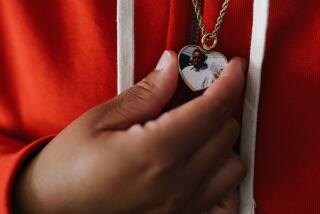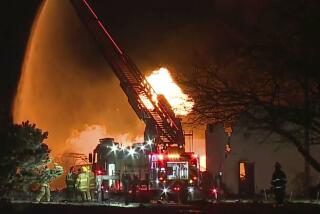‘It’s like we’re expendable’: Detroit’s first responders fall to COVID-19 pandemic
DETROIT — The downtown homeless center has been closed for the duration of the pandemic. A shelter has been temporarily set up three miles away.
And so the wretched wander the business district, pitching camp on the sidewalks, warming their suppers and sandwiches on the sewer caps that billow with steam.
Cutting through the fog and vapors of a gloomy Saturday night was the king-size silhouette of Sgt. Michael “Action” Jackson, a figure of stability in a time of pestilence.
“What you doing?” he asks a shabby man flopped in a restaurant vestibule.
“Nothing.”
“Nothing, huh? You hungry?”
“Yeah,” says the homeless man.
“I’ll see what I can do,” says Jackson.
The homeless man goes back to sleep, and Jackson moves along.
“It’s usually jumping on a Saturday,” he says. “Now it’s only homeless. They’re hungry. No one to beg change from. They’re starting to smash windows and that kind of thing. I think we’re just seeing the beginning.”
Detroit is a town accustomed to waving its middle finger to authority. But even Detroit is listening tonight.
“That’s how you know people are scared of this thing,” Jackson says. “Though we did have to bust up a stripper party in the casino hotel. Girl’s gotta eat sorta thing.”
The fear of an invisible silent killer has rippled through the ranks.
The captain of the homicide department is dead.
The commander of the jail is dead.
The chief of police — James Craig, an LAPD veteran — is ill.
About a fifth of the police force is in quarantine, and as of Monday, 39 members of the department had contracted the coronavirus.
“To be honest,” says Jackson, only half-joking, “you pretty much gotta kill somebody to get arrested. I mean we’re still gonna be the police, but nobody wants to get into a car with somebody breathing all over you if you don’t got to.”
In the neighborhoods far from downtown, it’s another matter. Mayhem continues in those quarters of Motown. And the police are more undermanned than usual. There have been 10 murders and 60 shootings in the three weeks since the governor declared a state of emergency. And even with life coming to a virtual standstill over the last month, murder has spiked more than 50% and nonfatal shootings 33% over the same time period last year.
And now comes the tsunami.
Dr. Anthony Fauci, the director of the National Institute of Allergy and Infection Diseases, pronounced himself “worried about Detroit” on “Good Morning America” on Monday. “Detroit is starting to show some signs that they’re going to take off.”
As of Tuesday, Michigan had the fourth-largest count of confirmed COVID-19 cases in the United States, tallying approximately 7,600, with 259 deaths. And Detroit, with just 7% of the state’s population, had suffered more than one-quarter of all infections, and more than one-quarter of the deaths.
“Detroit and Wayne County has one of the largest international borders in the United States. There is tremendous poverty, people suffer from environmental injustice and there is a larger concentration of old people,” said Bill Nowling, a spokesman for the Wayne County executive.
“This is new territory for all of us,” he says. “People need to stay home and let the first responders and healthcare folks get a handle on this.”
Poverty explains part of it. But so does governmental ineptitude and a lack of preparedness.
Nearly two decades after the Sept. 11 attacks, no emergency drill has been conducted in the streets of Detroit in recent memory, no master plan for disaster response has been unveiled, and the county jails are an unmitigated health disaster.
Gov. Gretchen Whitmer, a Democrat, took to a national morning show to criticize the lack of emergency help from Washington. Returning the favor, President Trump took to a national evening show to criticize the governor’s ability, tagging her with the nickname “Half-Whitmer.”
Meanwhile, the governor and the citizens together learned from the morning newspaper that the state had failed to file appropriate paperwork with the federal government to receive emergency aid.

The epicenter of the Detroit pandemic appears to be in the downtown jails. As of Monday, 48 deputies and sheriff’s department employees had contracted the virus, meaning 1 of every 125 confirmed COVID-19 cases in the state are centered there.
The jailhouse commander who died last week, Donafay Collins, was also a well-known deejay.
A tour of the jail two weeks ago revealed squalor and filth. The intake room was sticky with crumbs, insects and stained with spilled fruit punch, giving the place the look of a homicide scene. At intake, no health questions were asked of inmates before they were booked into cells with men. No temperatures are checked. The stainless steel showers there have not worked in at least five years. Clothing is not vacuum-packed. The toilets in the holding block were leaking. Roaches and black mold pervaded.
Deputies and nurses complained of insufficient protective gear and cleaning supplies.
“Bro, I know I’m gonna get sick in here, but I’m a soldier,” said a sheriff’s deputy, who spoke on condition of anonymity because the deputies had been ordered not to speak to the news media. “I just hope I’m healthy enough not to die. It’s like we’re expendable. It really messes your mind.”
Since then, to alleviate potential exposure, the county released 400 inmates back to the streets, but it did so without so much as checking the inmates with a thermometer.
To date, not one inmate in the three jail facilities has tested positive for the coronavirus because not one inmate has been tested, county officials confirm.
“They are inhumane conditions, there’s no doubt about it,” says Robert Dunlap, the chief of jails. “And we’re doing the best we can with what we have.”
In January, Whitmer released a blue-ribbon report about the state of county jails and incarceration across Michigan, but no one on the commission had worked in the Wayne County system.
The Wayne County jails have been under court supervision for four decades because of poor health conditions among inmates. The U.S. Department of Justice has opened an investigation into the mental health care provided for inmates after a spate of suicides.
A new jail and courthouse complex is under construction, but it is tens of millions of dollars over budget and at least a year from completion.
An initial attempt to build a new jailhouse was abandoned in 2013 in a wave of scandal and ineptitude. Ultimately, $400 million was bulldozed into the ground on that project. No one ever served a day in jail.
“Imagine what we could be doing with that money right now,” said Reginald Crawford, president of the Wayne County Deputy Sheriff’s Assn. “My people are exposed to a deadly virus. We don’t have things as simple as bleach. It’s demoralizing.”
Crawford spoke by telephone from his home, where he is battling the coronavirus.
The pandemic is exposing the chasm between the haves and never-hads in America’s poorest big city.
Since emerging from its historic bankruptcy in 2014, stories of downtown development — rejuvenated skyscrapers, a new hockey arena (built with public money diverted from public schools) and high-end steak houses — have gotten attention.
At the same time, there have been more than 100,000 water service cut-offs because of a lack of payment. The city’s health director in 2017 rejected the idea that those water shutoffs constituted a public health crisis. That health director, Dr. Joneigh S. Khaldun, now works for Whitmer as the state’s chief medical executive. On Sunday, Whitmer announced a moratorium on water shutoffs, allowing those with unpaid bills to wash their faces and hands.
A doctor from the Detroit Medical Center called this journalist in the middle of the night in tears. They have too little staff, too little equipment, too little everything, he said.
Then again, it was little better before the pandemic. The for-profit hospital chain has been sued by its own doctors for lack of staffing and investigated by the federal government for unsanitary equipment.
“Our top priority is making sure our patients, our staff, and our community remains safe,” the Detroit Medical Center said in a statement.
The Detroit public schools — among the worst in the country — were slow to close because there was no plan in place to feed the thousands of children who depend on federal food programs.
The garbage men complain of having no gloves or masks. The bus drivers temporarily walked off the job. Now they’re back, crisscrossing the city in empty coaches. The homeless shamble about, pressing their fingers and noses to plate-glass windows, hunting for something to eat.
And the Wayne County medical examiner is scheduled to take possession of two refrigerated tractor-trailers to handle the expected overflow.
Downtown on Saturday night, Sgt. Jackson’s radio began to bleat. “Shots fired. Location, Grand River and Cass.” A few blocks from police headquarters.
And with that, Action Jackson sped off into the gloom, the homeless man still hungry in the vestibule.
As of Wednesday, Jackson was in quarantine.
LeDuff, the author of “Detroit: An American Autopsy,” is a special correspondent.
More to Read
Sign up for Essential California
The most important California stories and recommendations in your inbox every morning.
You may occasionally receive promotional content from the Los Angeles Times.











